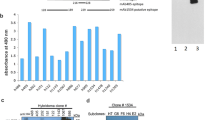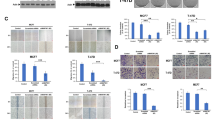Abstract
Background
The transcriptional factors E2F1 and E2F2 have been reported to be associated with improved chemosensitivity in various cancers. We aimed to investigate whether E2F1 and E2F2 can be used as predictors of chemosensitivity in hormone-receptor-negative breast cancers (HRNBCs), which are common in Korean women.
Methods
A total of 183 patients with primary breast cancer who had undergone surgical resection were evaluated on the basis of hormonal status, age, histological subtype and grade, tumor size, lymph node metastasis, and stage. The immunohistochemical expressions of E2F1 and E2F2 were analyzed for these histopathological data and patient survival.
Results
E2F1 expression was associated with low histological grade (grade 1) and larger tumor size (>2 cm), while E2F2 expression was correlated only with large tumor size (>2 cm). The E2F1-positive group had less tumor recurrences, lymph node metastases during follow-up, and distant metastases than the E2F1-negative group; E2F1 expression was found to be an independent predictive factor of more favorable survival among HRNBC patients on univariate and multivariate analyses, but E2F2 expression was not.
Conclusions
E2F1 may be a potential prognostic and predictive factor for clinical outcome and therapeutic results following adjuvant chemotherapy in HRNBC patients.


Similar content being viewed by others
References
Lee JH, Yim SH, Won YJ, Jung KW, Son BH, Lee HD, et al. Population-based breast cancer statistics in Korea during 1993–2002: incidence, mortality, and survival. J Korean Med Sci. 2007;22:S11–6.
Argarwal G, Pradeep PV, Aggarwal V, Yip CH, Ceung P. Spectrum of breast cancer in Asian women. World J Surg. 2007;31:1031–40.
Greenberg PA, Hortobagyi GN, Smith TL, et al. Long-term follow-up of patients with complete emission following combination chemotherapy for breast cancer. J Clin Oncol. 1996;14:2197–205.
Chopra R. The Indian scene. J Clin Oncol. 2001;19:(18)106–11.
Khan SA, Rogers MA, Khurana KK, Mequid MM, Numann PJ. Estrogen receptor expression in benign breast epithelium and breast cancer risk. J Natl Cancer Inst. 1998;90:37–42.
Kushlinskii NE, Gershtein ES. Modern prospects for molecular-biochemical methods for evaluating biological “behavior” of breast neoplasms. Vestn Ros Akad Med Nauk. 2001;9:65–70.
Howell A, Cuzick J, Baum M, Buzdar A, Dowsett M, Forbes JF, et al. Results of the ATAC (Arimidex, Tamoxifen, Alone or in Combination) trial after completion of 5 years’ adjuvant treatment for breast cancer. Lancet. 2005;365:60–2.
Winer EP, Hudis C, Burstein HJ, Wolff AC, Pritchard KI, Ingle JN, et al. American society of clinical oncology technology assessment on the use of aromatase inhibitors as adjuvant therapy for postmenopausal women with hormone receptor-positive breast cancer: status report 2004. J Clin Oncol. 2005;23:619–29.
Sherr CJ. Cancer cell cycles. Science. 1996;274:1672–7.
Stevens C, La Thangue NB. E2F and cell cycle control: a double-edged sword. Arch Biochem Biophys. 2003;412:157–69.
Attwooll C, Lazzerini Denchi E, Helin K. The E2F family: specific functions and overlapping interests. EMBO J. 2004;23:4709–16.
La Thangue NB. The yin and yang of E2F1: balancing life and death. Nat Cell Biol. 2003;5:587–9.
Lee JY, Park CK, Park JO, Lim T, Park YS, Lim HY, et al. Impact of E2F1 expression on clinical outcome of gastric adenocarcinoma patients with adjuvant chemoradiation therapy. Clin Cancer Res. 2008;14:82–8.
Belvedere O, Puglisi F, Di Loreto C, Cataldi P, Guglielmi A, Aschele C, et al. Lack of correlation between immunohistochemical expression of E2F1, thymidylate synthase expression and clinical response to 5-fluorouracil in advanced colorectal cancer. Ann Oncol. 2004;15:55–8.
Han SH, Park KM, Bae BN, Kim KH, Kim HJ, Kim YD, et al. E2F1 expression is related with the poor survival of lymph node-positive breast cancer patients treated with fluorouracil, doxorubicin and cyclophosphamide. Breast Cancer Res Treat. 2003;82:11–6.
Kim EY, Jo HJ, Lee MJ. Expressions of E2F4 and E2F2 transcription factors in breast carcinoma. Korean J Pathol. 2005;39:301–6.
Saiz AD, Olvera M, Rezk S, Florentine BA, McCourty A, Brynes RK. Immunohistochemical expression of cyclin D1, E2F1, and Ki-67 in benign and malignant thyroid lesions. J Pathol. 2002;198:157–62.
Eymin B, Gazzeri S, Brambilla C, Brambilla E. Distinct pattern of E2F1 expression in human lung tumours: E2F1 is up-regulated in small cell lung carcinoma. Oncogene. 2001;20:1678–87.
Zhang SY, Liu SC, Al-Saleem LF, Holloran D, Babb J, Guo X, et al. E2F1: a proliferative marker of breast neoplasia. Cancer Epidemiol Biomarkers Prev. 2000;9:395–401.
Kim JY, Kim HW, Choi KU, Lee CH, Sol MY, Kang HJ, et al. Alteration of G1/S cell cycle regulatory proteins in ovarian epithelial tumors. Korean J Pathol. 2006;40:274–81.
Zacharators P, Kotsinas A, Evangelou K, Karakaidos P, Vassiliou LV, Rezaei N, et al. Distinct expression patterns of the transcription factor E2F1 in relation to tumour growth parameters in common human carcinomas. J Pathol. 2004;203:744–53.
Rabbani F, Richon VM, Orlow I, Lu ML, Drobnjak M, Dudas M, et al. Prognostic significance of transcription factor E2F-1 in bladder cancer: genotypic and phenotypic characterization. J Natl Cancer Inst. 1999;91:874–81.
Ho GH, Calvano JE, Bisogna M, Van Zee KJ. Expression of E2F1 and E2F4 is reduced in primary and metastatic breast carcinomas. Breast Cancer Res Treat. 2001;69:115–22.
Verlinden L, Vanden Bempt I, Eelen G, Drijkoningen M, Verlinden I, Marchal K, et al. The E2F-regulated gene Chk1 is highly expressed in triple-negative estrogen receptor-/progesterone receptor-/HER2- breast carcinomas. Cancer Res. 2007;67:6574–81.
Pruschy M, Wirbelauer C, Glanzmann C, Bodis S, Krek W. E2F1 has properties of a radiosensitizer and its regulation by cyclin A kinase is required for cell survival of fibrosarcoma cells lacking p53. Cell Growth Differ. 1999;10:141–6.
Elliott MJ, Farmer MR, Atienza C Jr, Stilwell A, Dong YB, Yang HL, et al. E2F1 gene therapy induces apoptosis and increases chemosensitivity in human pancreatic carcinoma cells. Tumour Biol. 2002;23(2):76–86.
Yamasaki L. Balancing proliferation and apoptosis in vivo: the goldilocks theory of E2F/DP action. Biochim Biophys Acta. 1999;1423:M9–15.
Yamasaki L, Jacks T, Bronson R, Goillot E, Harlow E, Dyson NJ. Tumor induction and tumor atrophy in mice lacking E2F1. Cell. 1996;85:537–48.
Acknowledgment
The authors would like to thank Moon Sook Oh for her excellent technical assistance.
Author information
Authors and Affiliations
Corresponding author
Rights and permissions
About this article
Cite this article
Kwon, M.J., Nam, E.S., Cho, S.J. et al. E2F1 Expression Predicts Outcome in Korean Women Who Undergo Surgery for Breast Carcinoma. Ann Surg Oncol 17, 564–571 (2010). https://doi.org/10.1245/s10434-009-0767-z
Received:
Published:
Issue Date:
DOI: https://doi.org/10.1245/s10434-009-0767-z




